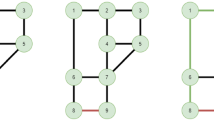Abstract
Given a graph G=(V,E), the Hamiltonian completion number of G, HCN(G), is the minimum number of edges to be added to G to make it Hamiltonian. This problem is known to be \(\mathcal{NP}\) -hard even when G is a line graph. In this paper, local search algorithms for finding HCN(G) when G is a line graph are proposed. The adopted approach is mainly based on finding a set of edge-disjoint trails that dominates all the edges of the root graph of G. Extensive computational experiments conducted on a wide set of instances allow to point out the behavior of the proposed algorithms with respect to both the quality of the solutions and the computation time.
Similar content being viewed by others
References
Agnetis, A., Detti, P., Meloni, C., & Pacciarelli, D. (2001a). Set-up coordination between two stages of a supply chain. Annals of Operations Research, 107, 15–32.
Agnetis, A., Detti, P., Meloni, C., & Pacciarelli, D. (2001b). A linear algorithm for the Hamiltonian completion number of the line graph of a tree. Information Processing Letters, 79, 17–24.
Agnetis, A., Detti, P., & Meloni, C. (2003). Process selection and sequencing in a two-agents production system. 4OR, 1(2), 103–119.
Aigner, M., & Andreae, T. (1989). The total interval number of a graph. Journal of Combinatorial Theory Series B, 46, 7–21.
Applegate, D., Bixby, R., Chvàtal, V., & Cook, W. (2003). Implementing the Dantzig-Fulkerson-Johnson algorithm for large traveling salesman problems. Mathematical Programming, 97, 91–153.
Balas, E., & Vazacopoulos, A. (1998). Guided local search with shifting bottleneck for job shop scheduling. Management Science, 44(2), 262–275.
Bertossi, A. A. (1981). The edge Hamiltonian problem is NP-hard. Information Processing Letters, 13, 157–159.
Bonuccelli, M. A., & Bovet, D. P. (1979). Minimum node disjoint path covering for circular-arc graphs. Information Processing Letters, 8(4), 159–161.
den Besten, M., Stützle, T., & Dorigo, M. (2001). Design of iterated local search algorithms: an example application to the single machine total weighted tardiness problem. In Lecture notes in computer science (Vol. 2037, pp. 441–451).
Detti, P., & Meloni, C. (2001). Part type selection and batch sequencing in a two-stage manufacturing system. In Proceedings of 16th international conference on production research, Praha.
Detti, P., & Meloni, C. (2004). A linear algorithm for the Hamiltonian completion number of the line graph of a cactus. Discrete Applied Mathematics, 136, 197–215.
Detti, P., Meloni, C., & Pranzo, M. (2004). Simple bounds for the minimum cardinality dominating trail set problem (Technical report RT-DIA-87-2004). Dipartimento di Informatica e Automazione, Università Roma Tre, Roma, Italy.
Gamarnik, D., & Sviridenko, M. (2005). Hamiltonian completions of sparse random graphs. Discrete Applied Mathematics, 152, 139–158.
Hansen, P., & Mladenovic, N. (2001). Variable neighborhood search: principles and applications. European Journal of Operational Research, 130, 449–467.
Harary, F., & Nash-Williams, C. S. J. A. (1965). On Eulerian and Hamiltonian graphs and line-graphs. Canadian Mathematics Bulletin, 8, 701–709.
Hoos, H. H., & Stützle, T. (2004). Stochastic local search—foundations & applications. San Francisco: Morgan Kaufmann.
Johnson, D. S., & McGeoch, L. A. (1997). The travelling salesman problem: a case study in local optimization. In Local search in combinatorial optimization (pp. 215–310). New York: Wiley.
Kratzke, T. M., & West, D. B. (1993). The total interval number of a graph, I: fundamental classes. Discrete Mathematics, 118, 145–156.
Kundu, S. (1976). A linear algorithm for the Hamiltonian completion number of a tree. Information Processing Letters, 5, 55–57.
Lai, T. H., & Wei, S. S. (1995). Algorithms for page retrieval and Hamiltonian paths on forward-convex line graphs. Journal of Algorithms, 18, 358–375.
Lehot, P. G. H. (1974). An optimal algorithm to detect a line graph and output its root graph. Journal of the ACM, 21, 569–575.
Lin, R., Olariu, S., & Pruesse, G. (1995). An optimal path cover algorithm for cographs. Computers and Mathematics with Applications, 30(8), 75–83.
Lourenço, H. R. D., Martin, O., & Stützle, T., (2002). Iterated local search. In F. Glover & G. Kochenberger (Eds.), Handbook of metaheuristics (pp. 321–353). Dordrecht: Kluwer Academic.
Nikolopoulos, S. D. (2004). Parallel algorithms for Hamiltonian problems on quasi-threshold graphs. Journal of Parallel and Distributed Computing, 64, 48–67.
Rao Arikati, S., & Pandu Rangan, C. (1990). Linear algorithm for optimal path cover problem on interval graphs. Information Processing Letters, 35, 149–153.
Raychaudhuri, A. (1995). The total interval number of a tree and the Hamiltonian completion number of its line graph. Information Processing Letters, 56, 299–306.
Roussopoulos, N. D. (1973). A max {m,n} algorithm for determining the graph H from its line graph G. Information Processing Letters, 2, 108–112.
Skupień, Z. (1976). Hamiltonian shortage, path partitions of vertices, and matchings in a graph. Colloquium Mathematicum, 36(2), 305–318.
Smyth, K., Hoos, H. H., & Stützle, T. (2003). Iterated robust tabu search for MAX-SAT. In Lecture notes in computer science (Vol. 2671, pp. 129–144).
Srikant, R., Sundaram, R., Singh, K. S., & Pandu Rangan, C. (1993). Optimal path cover problem on block graphs and bipartite permutation graphs. Theoretical Computer Science, 115, 351–357.
Stützle, T. (1998). Applying iterated local search to the permutation flow shop problem (Technical report AIDA-98-04). FG Intellektik, TU Darmstadt.
Veldman, H. J. (1988). A result on Hamiltonian line graphs involving restrictions on induced subgraphs. Journal of Graph Theory, 12(3), 413–420.
Voß, S., Martello, S., Osman, I.H., & Roucairol, C. (Eds.). (1999). Meta-heuristics: advances and trends in local search paradigms for optimization. Dordrecht: Kluwer Academic.
Wu, Q. S., Lu, C. L., & Lee, R. C. T. (2000). An approximate algorithm for the weighted Hamiltonian path completion problem on a tree. In Lecture notes in computer science (Vol. 1969, pp. 156–167).
Author information
Authors and Affiliations
Corresponding author
Rights and permissions
About this article
Cite this article
Detti, P., Meloni, C. & Pranzo, M. Local search algorithms for finding the Hamiltonian completion number of line graphs. Ann Oper Res 156, 5–24 (2007). https://doi.org/10.1007/s10479-007-0231-z
Published:
Issue Date:
DOI: https://doi.org/10.1007/s10479-007-0231-z




